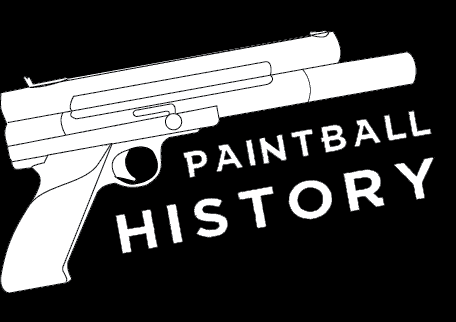In January of 2016 I hung out with Black Sunday at the 2016 SC Village UWL practice. Rick Cendejas was there and showed Benji and I two classic Minicockers he kept around from the early 1990s.

I recognized one of Rick’s Minicockers as the paintgun he posed with on his 1993 Smart Parts Ironmen trading card.
The other Minicocker that Rick brought out was a neat cut up and matched splashed paintgun that featured a few innovative designs.

Both cockers were in somewhat neglected shape and showed signs of water damage or constant exposure to moister over the years. Rick explained that these Cockers and some other gear were stored in “a waterproof container” which cracked over time and “rain came in through the cracks. Lots of stuff was ruined and [he] was sick about it.”
The issues main issues appeared to be light surface damage, consisting of rust and oxidization. The anodized aluminum looked surprisingly clean though. These cockers could potentially be a challenge to get apart but should reassemle easy enough and be shooting without too much of an issue.

So in January of 2016 I purchased the stock bodied Mini from Rick and Benji purchased the splash and cut Mini. The stock bodied Minicocker had more historical significance from my point of view, since it was likely the first cocker that Rick used on the Ironmen. Although as Rick has explained, he didn’t play much with the Cockers, moving from a Line SI, to an Hurricane to an F1. But in the Smart Parts’ 1993 trading cards Rick is pictured with this Minicocker so I imagine he used it on and off from March 1991 until 1994. The Illustrator came out in fall (October) of 1990 (although not publicly released till a little later) so Rick probably used his Illustrator from end of 1990/early 1991 on and off for a couple years.
Rick’s Ironmen Minicocker
I rebuilt the stock bodied Mini over the summer, but when I went to test it I realized the timing wasn’t dialed in correctly. I haven’t gone back to tweak it but will eventually document it’s restoration in a later article.
Rick’s Splash Minicocker
Several months back, Benji decided to sell me the splash Mini. Although never a gun Rick used heavily (or at all?), this Minicocker has a couple unique features. The anodizing matches perfectly with a Dirk Gadberry Autococker I purchased last year that was built for Greg Taylor (Bob Long’s Ironmen / Ironmen II), but aside from the anodizing, the features don’t match anything I’d seen on Gadberry’s (Innovative Manufacturing) Autocockers, or Bob Long cockers from the mid 90s.

The History behind Rick’s Splash Minicocker
I asked Rick about the cuts and he explained that he cut this custom Minicocker while working as a machinist at Concord Naval Weapons Station. The base gun was a stock Mini he received as part of the Ironmen’s sponsorship with Worr Game Products. Rick writes, “This Autococker was acquired during our sponsorship in the early 1990’s, probably close to 1992. I did not make it a Mini, so it must have come that way.”
Rick estimates this cocker was built prior to 1994, and coincided with the first splash anodizing jobs being offered by Bob Long. The feed was likely from Pro Team Products / Gun FX.
I sent a photo to Dirk Gadberry and he thinks the Anodizing was done by “Ano Tech in central California.” Rick remembers that he used the same shop Bob Long was using at the time for splash anodizing.
The sad thing about this Mini is that Rick doesn’t remember ever using it!
He writes, “I don’t think it was ever played with [it] or that it was ever shot after all of the work. I was using other markers and it kind of just fell by the wayside.”

Unique Modifications
I was also curious why Rick decided to attach a powerfeed? Not only is it odd that he chose a powerfeed, but the decision to weld it prior to anodizing was unique. The main issue I have see with the Pro Team Products powerfeeds are the threading on the screws stripping out. Rick commented that he “was impressed with the power feed on [his] wife’s MiniMag and the ability to stop the balls from dropping [in].”
On Rick’s Line SI Bushmaster I own I’ve noticed several modifications that Rick added on including the pump handle T grip and a brass hammer. On Rick’s early Ironmen Minicocker, pictured above, there are a ton of small cuts that Rick did himself.

And although Rick was a machinist by trade during this period and customized his own markers, he didn’t do any complete paintguns for his teammates. He did drill barrel porting in a spiral rifled style similar to Smart Parts’ rifling for some teammates and added additional muzzle porting (as seen on the above Ironmen Minicocker).
Rick writes, “I did a lot of barrel porting for the [Ironmen] soon after seeing Smart Parts’ barrels.”
Disassembly
Breaking down this cocker wasn’t as much of a challenge as I expected. As Rick explained, this cocker must have not seen much use, since the none of the screw threads were worn to raw aluminum. Luckily this meant all threads were sufficiently protected against the elements over the last two decades.
I broke this cocker down with the help of Tim Firpo, of Paintball Tek dot com, and we examined the pieces.
The match anodized Armson came apart without issues. I’ll likely need to buy another site to replace the rusty pieces. The dot was also somewhat blurred and still is after cleaning. I might just swap out all internals from another Armson ocular site eventually.
Reassembly (to be continued)…
The Air America Unireg had the 1/8th npt burst disc nut completely rusted in. Not a problem, I’ll find a replacement Unireg (or a stabilizer to use in the meantime).

The trigger plate had significant play so I swapped it out with a thicker plate. The steel stem on the cup seal was rusted into the valve. After the cup seal was switched out, the valve seemed okay.
The Rock, ram and switch are still awaiting a rebuild. Once those are complete I will be testing it out.
Giant thanks to Rick Cendejas for allowing me the opportunity to own these two Autocockers. Another thanks to to Benji for selling the Minicocker he bought from Rick. I’m also glad I had Tim at Paintballtek by my side during the disassembling (I couldn’t have taken the trigger shoe off without him!).
Find more on Rick’s paintball history at: www.baccipaintball.com/oldnews/tag/rick-cendejas







